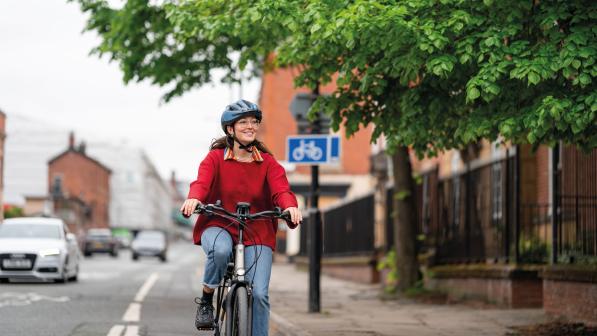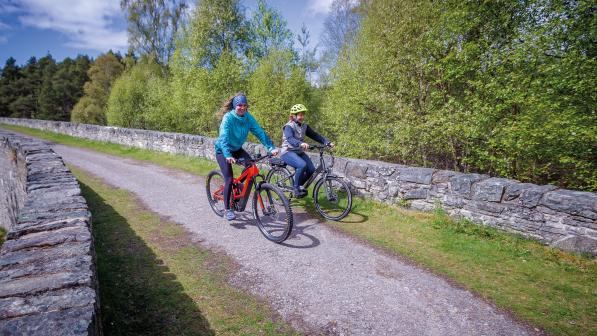The UK's cycle network: Brilliant in parts, broken in others

A set of stairs with a bollard on them was uniquely obstructive, even by National Cycle Network (NCN) standards. I’d had a delightful day’s riding on country lanes and magical off-road paths in the countryside around Loch Lomond but, even after a year or so’s exploration of the NCN, its good bits and bad bits, this surprised even me.
Don’t get me wrong: I love our NCN. Last year, I wrote a book detailing some of the wonderful, surprising, joyful and maddening things about it. I’d cycled to awe-inspiring places across Britain. I’d seen lives transformed by a new walking and cycling bridge reconnecting canal-side communities after more than a century. I’d seen how a protected cycle lane on a busy urban road had enabled groups of Muslim women to cycle confidently for the first time.

On a macro as well as a micro level, from the politics that fund (or don’t fund) cycle routes in the UK, to the weird details like the stairs bollard (were they expecting particularly ingenious daleks?), I’d pretty much seen it all. And while the little blue signs took me to some truly delightful places, and clearly a lot has gone right with it, it’s just as clear that a lot has gone wrong.
Does the network work?
On my travels I found myself asking: what is a cycle network? What would it look like if we were to do it properly? The answer really depends whom you’re asking. It could resemble the continuous network of dependable paths in the Netherlands that take people anywhere they need to go. Here in the UK, well, it’s a bit more complicated.
For one thing, just 26% of Brits have even heard of the National Cycle Network. I remember introducing an ex to the blue and red stickers pasted on street furniture alongside pavements and stretches of otherwise unaltered road in London, and seeing his bewilderment and wonder. Every spring, Sustrans, the network’s charitable custodian, prints thousands of these stickers to send out to volunteers up and down the country, marking out what is, in theory, a piece of national infrastructure. Sometimes it is little more than those blue signs.
Then there’s the quality level: if a UK cycle route takes you all the way from A to B with consistently good-quality infrastructure, that’s rare. At the latest reckoning, just 64% of the NCN was deemed good or very good by Sustrans, leaving 36% poor or very poor: bits with barriers, shared with too many vehicles, or with a poor surface – things that bar non-standard cycle users or those who can’t pick up their cycle.
While Sustrans has improved some of it – since 2019 switching 11 on-road miles here to traffic free, and 17 miles there to quiet ways; removing or redesigning 615 barriers; and delivering 50 ‘activation projects’ to complete missing links – it is far from a proper, dependable network with a truly national reach. Sustrans aims to improve it further, increasing the proportion of train stations it connects to from a measly 42% to 60%, as well as linking to new homes and to green space, and improving routes to schools. There’s currently no funding for this vision, however.

Why is it like this?
In the UK, as anywhere, a cycling network is delivered by a patchwork of agencies. In our case it ranges from local councils to National Highways (yes, the trunk roads people), and from Sustrans to volunteers.
As with roads, those different agencies maintain it – in theory, at least. However, there’s no sustained long-term funding for cycle routes in the UK. (The Scottish government did set out multi-year funding, before cutting its active travel budget by £23.7m in 2024.) Unlike roads, there’s no maintenance budget for cycle routes either.
This means routes crumble over time or, as is increasingly common, fall foul of extreme weather. The Bath Two Tunnels route in Somerset was flooded for much of 2024, until the council eventually gathered the funds and equipment to pump the water out. Without maintenance budgets, Sustrans’ CEO Xavier Brice pointed out to me that there’s an active disincentive for councils to deliver new routes. Infrastructure without maintenance funding can simply be termed ‘a liability’.

People power
How did our cycle network come to be run by a charity using a seat-of-our-pants approach to government support, while roads and rail are overseen by government bodies with long-term funding settlements? You may well ask. Perhaps my favourite bit of writing a book on this was learning the amazing story of the Bristolian environmental campaigners who decided, in the absence of government or council support, to try to develop their own cycle routes.
What a job they did! With almost no money and a lot of free labour, in the six years to 1985 they built the Bristol and Bath Railway Path.
Thanks to guidance from John Grimshaw, one of Sustrans’ founders and a civil engineer, other campaigners delivered similar paths connecting York and Selby, Derby and Melbourne, the Liverpool Loop and the Consett and Sunderland path. Come the mid-1990s, Sustrans, with just 25 staff, won £42.5m from the National Lottery, seed funding the charity’s idea for a national network.

Local councils, charities, landowners and supporters were persuaded to chip in four times that sum, turning lines on a map into navigable routes. While some of it was signposts plonked beside 3,464 miles of road – along with 150 miles of pavement or footpath, some verges, forest tracks and footbridges with steps – this diminutive task force managed to deliver 272 miles of new routes on old railway lines, canal towpaths and the like. By the millennium there was a 10,000-mile network of sorts.
What Sustrans, its volunteers and their countless supporters in councils and organisations nationwide achieved cannot be underestimated. Through considerable negotiating and marketing skills, and a good measure of sheer belief, hard work and determination, they delivered one of the first national cycle networks in Europe.
In France, Denmark and Germany similar campaigns for cycle routes were growing. However, while their national governments backed the idea and funded an ongoing programme of path development, with local governments contributing their own funds, in the UK the momentum petered out once the money was spent. The volunteer-and-charitable model was never sustainable.
I have no real answer for why we find ourselves in this situation, other than looking at what happens when the UK tries to deliver transport infrastructure of any kind today. Our previous government thought, for example, that a flagship rail link between England’s major cities, HS2, would do fine if it stopped just outside London. We tend to think of transport in silos. We deliver homes that are only accessible by car, without rail links, bus, walking or cycling connections. And we generally fail to properly plan and fund projects long term. It’s something this government says it is looking to resolve in its Integrated Transport Strategy – including for cycling. Time will tell how that pans out.

Answers on a postcard
The solutions are not complicated. Given the funds, the political backing and the working capacity, we could deliver a National Cycle Network worthy of the name within four years. We already have £16bn earmarked for ‘low-value’ road projects that should be redirected, and a large body – National Highways – with the capacity to deliver cycle routes.
We could meet Sustrans’ aim to connect settlements of 10,000 people or more, building new routes beyond the hedgerow of existing roads, and we could fund local authorities to connect those routes to urban networks. We could designate some streets as ‘through’ roads and some as ‘access’ roads, akin to low traffic neighbourhoods, as the Dutch do.
Following almost a decade of route construction, London cycling trips have increased an impressive 26% since 2019; they’re up 6% since 2023 alone. Data already tells us where there’s the highest potential for cycle trips, using the Propensity to Cycle Tool, while local authorities’ Cycling and Walking Infrastructure Plans, or LCWIPs, tell us where councils’ priority routes would go.
Given less than £20bn, we could deliver enough rural and urban routes to meet the target that half of our walking and cycling trips are made by bike. We just need to get on and do it.


